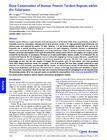Deep Conservation of Human Protein Tandem Repeats within the Eukaryotes
dc.contributor.author
Schaper, Elke
dc.contributor.author
Gascuel, Olivier
dc.contributor.author
Anisimova, Maria
dc.date.accessioned
2021-06-02T16:34:54Z
dc.date.available
2017-06-11T08:28:48Z
dc.date.available
2021-06-02T16:34:54Z
dc.date.issued
2014-05
dc.identifier.issn
0737-4038
dc.identifier.issn
1537-1719
dc.identifier.other
10.1093/molbev/msu062
en_US
dc.identifier.uri
http://hdl.handle.net/20.500.11850/84140
dc.identifier.doi
10.3929/ethz-b-000084140
dc.description.abstract
Tandem repeats (TRs) are a major element of protein sequences in all domains of life. They are particularly abundant in mammals, where by conservative estimates one in three proteins contain a TR. High generation-scale duplication and deletion rates were reported for nucleic TR units. However, it is not known whether protein TR units can also be frequently lost or gained providing a source of variation for rapid adaptation of protein function, or alternatively, tend to have conserved TR unit configurations over long evolutionary times. To obtain a systematic picture, we performed a proteome-wide analysis of the mode of evolution for human protein TRs. For this purpose, we propose a novel method for the detection of orthologous TRs based on circular profile hidden Markov models. For all detected TRs, we reconstructed bispecies TR unit phylogenies across 61 eukaryotes ranging from human to yeast. Moreover, we performed additional analyses to correlate functional and structural annotations of human TRs with their mode of evolution. Surprisingly, we find that the vast majority of human TRs are ancient, with TR unit number and order preserved intact since distant speciation events. For example, ≥61% of all human TRs have been strongly conserved at least since the root of all mammals, approximately 300 Ma. Further, we find no human protein TR that shows evidence for strong recent duplications and deletions. The results are in contrast to the high generation-scale mutability of nucleic TRs. Presumably, most protein TRs fold into stable and conserved structures that are indispensable for the function of the TR-containing protein. All of our data and results are available for download from http://www.atgc-montpellier.fr/TRE.
en_US
dc.format
application/pdf
en_US
dc.language.iso
en
en_US
dc.publisher
Oxford University Press
en_US
dc.rights.uri
http://creativecommons.org/licenses/by/3.0/
dc.subject
Protein evolution
en_US
dc.subject
Tandem repeats
en_US
dc.subject
Cconservation
en_US
dc.subject
Phylogenetic analysis
en_US
dc.title
Deep Conservation of Human Protein Tandem Repeats within the Eukaryotes
en_US
dc.type
Journal Article
dc.rights.license
Creative Commons Attribution 3.0 Unported
dc.date.published
2014-02-03
ethz.journal.title
Molecular Biology and Evolution
ethz.journal.volume
31
en_US
ethz.journal.issue
5
en_US
ethz.journal.abbreviated
Mol Biol Evol
ethz.pages.start
1132
en_US
ethz.pages.end
1148
en_US
ethz.version.deposit
publishedVersion
en_US
ethz.identifier.wos
ethz.publication.place
Oxford
en_US
ethz.publication.status
published
en_US
ethz.date.deposited
2017-06-11T08:29:11Z
ethz.source
ECIT
ethz.identifier.importid
imp593651e66ff6643750
ethz.ecitpid
pub:132782
ethz.eth
yes
en_US
ethz.availability
Open access
en_US
ethz.rosetta.installDate
2017-07-12T17:09:57Z
ethz.rosetta.lastUpdated
2024-02-02T13:50:58Z
ethz.rosetta.versionExported
true
ethz.COinS
ctx_ver=Z39.88-2004&rft_val_fmt=info:ofi/fmt:kev:mtx:journal&rft.atitle=Deep%20Conservation%20of%20Human%20Protein%20Tandem%20Repeats%20within%20the%20Eukaryotes&rft.jtitle=Molecular%20Biology%20and%20Evolution&rft.date=2014-05&rft.volume=31&rft.issue=5&rft.spage=1132&rft.epage=1148&rft.issn=0737-4038&1537-1719&rft.au=Schaper,%20Elke&Gascuel,%20Olivier&Anisimova,%20Maria&rft.genre=article&rft_id=info:doi/10.1093/molbev/msu062&
Files in this item
Publication type
-
Journal Article [128832]

